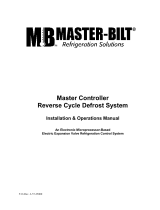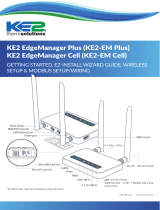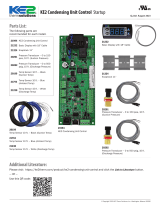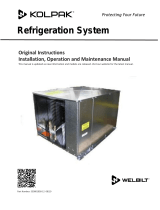Page is loading ...

1
IPS SERIES
INTERNET COMMUNICATION PARALLEL RACK SYSTEM
START UP GUIDE
07/21/2017
©2017 Master-Bilt Products, an unincorporated division of Standex International Corporation. All rights reserved.
Printed in U.S.A.

2

3
Contents
INTRODUCTION .............................................................................................................................. 4
WARNING LABELS AND SAFETY INSTRUCTIONS ................................................................. 5
PARALLEL RACK NOMENCLATURE .......................................................................................... 6
GENERAL RACK DESCRIPTION ................................................................................................... 7
TYPICAL REFRIGERATION COMPONENTS ............................................................................... 7
TYPICAL CONTROL/ POWER COMPONENTS............................................................................ 7
CONTROL THEORY ........................................................................................................................ 8
PRE-START UP ................................................................................................................................. 8
START UP .......................................................................................................................................... 8
CONTROLER(S) .............................................................................................................................. 10
STARTUP TROUBLESHOOTING ............................................................................................... 102
REFERENCE DOCUMENTS .......................................................................................................... 12

4
INTRODUCTION
Thank you for purchasing Master-Bilt refrigeration equipment. This manual contains important instructions for
startup, and troubleshooting. Read this entire manual carefully before starting or servicing your Master-Bilt
equipment.
NOTICE
Installation and service of the refrigeration and electrical components must be performed by a
refrigeration mechanic or licensed electrician.
DANGER
Equipment MUST be properly grounded.
Improper or faulty hook-up of electrical components of the refrigeration units can result in severe injury
or death. All electrical wiring hook-ups must be done in accordance with all applicable local, regional or
national standards.
NOTICE
Read this manual before installing your refrigeration equipment. Keep the manual and refer to it before
doing any service. Failure to do so could result in personal injury or equipment damage.
The portions of this manual covering refrigeration and electrical components contain technical instructions
intended only for persons qualified to perform refrigeration and electrical work.
This manual cannot cover every installation, use, or service situation. If you need additional information, call or
write us:
Parts and Technical Service Department
Master-Bilt Products
908 Highway 15 North
New Albany, MS 38652
Phone (800) 684-8988
Email: service@master-bilt.com

5
WARNING LABELS AND SAFETY INSTRUCTIONS
This is the safety-alert symbol. When you see this symbol, be alert to the potential for
personal
injury or damage to your equipment.
Be sure you understand all safety messages and always follow recommended precautions and safe operating
practices.
NOTICE TO EMPLOYERS
You must make sure that everyone who installs, uses, or services your refrigeration equipment is
thoroughly familiar with all safety information and procedures.
Important safety information is presented in this section and throughout the manual. The following signal words
are used in the warnings and safety messages:
DANGER:
Severe injury or death WILL occur if you ignore the message.
WARNING:
Severe injury or death CAN occur if you ignore the message.
CAUTION:
Minor injury or damage to your refrigeration can occur if you ignore
the message.
NOTICE:
This is important installation, operation or service information. If you ignore the message, you
may damage your refrigeration.
The warning and safety labels shown throughout this manual are placed on your Master-Bilt Products
refrigeration at the factory. Follow all warning label instructions. If any warning or safety labels
become lost or damaged, call your customer service department at (800) 684-8988 for replacements.
This Label is located on the condensing unit

6
PARALLEL RACK NOMENCLATURE
PS E A C 5 2 Z C
-
XXXXX
Quote Number
Voltage
A = 115/60/1
B = 208-230/60/1
C = 208-230/60/3
D = 460/60/1
E = 460/60/3
F = 200
-
220/50/3
G = 380-420/50/3
H = 208/60/1
J = 380/50/1
K = 200
-
220/50/1 or 220/50/1
L = 575/3/60
M = 200-230/60/3
R =265/60/1
T = 380/60/3
Refrigerant
Z = R404A
# Suction Groups
1 to 3
# Compressors
2 to 10
Condenser Location
R = Remote
I = Integrated
C = Mounted on Common Frame
Condensing Method
A = Air Cooled
W = Water Cooled
Frame
I = Interior
E = Exterior
Rack
PS = Standard Rack
GPS = Glycol Rack
IPS = Parallel Rack with Internet communications

7
GENERAL RACK DESCRIPTION
Master-Bilt PS series parallel rack systems operate with up to ten compressors in parallel design. A typical rack
system has two separate suction groups and a common discharge and liquid circuit. One suction group is for
low temperature equipment with an average temperature of -23°F SST. One suction group is for medium
temperature equipment with an average temperature of +23°F SST. Each rack system has one common liquid
circuit and one common discharge circuit.
TYPICAL REFRIGERATION COMPONENTS
• 2-10 Scroll or Discus compressors
• Individual Compressor Dual Pressure Controls
• Individual Compressor Oil Level Controls
• Oil Pressure Differential Valve
• Oil Line Sight Glass
• Oil Filter
• Oil Separator
• Air Cooled or Water Cooled Condenser
• Head Pressure and Hot Gas Bypass Valves
• Liquid Receiver with Dual Pressure Relief Valves
• Replaceable Core Liquid Filter/ Drier
• Liquid Sight Glass
• Replaceable Core Suction Filter (one for each group)
• Suction Accumulator (one for each group)
TYPICAL CONTROL/ POWER COMPONENTS
• 220V Control Circuit
• Main Disconnect Switch and Circuit Breaker
• Power Distribution Blocks
• GFCI Service Receptacle (115V)
• 1 or more KE2 Therm Compressor Sequencer Controller(s)
• 1 or more solid state relay (one per digital compressor)
• Individual Compressor Circuit Breakers
• Individual Compressor Contactors
• Condenser Fan Contactors
• Phase Monitor
• 230V to 24V Transformers for and Oil Controls Power
• Receiver Liquid Level Probe
• Suction, Discharge, and Drop Leg Pressure Transducers
• Suction, Discharge, Drop Leg, and Ambient Temperature Probes
• Walk-in Cooler/ Freezer Temperature Probes
• Walk-in Cooler/ Freezer Temperature controls
• Walk-in Cooler/ Freezer Temperature transducers
• Evaporator Suction Valve Simple Interface Board (if provided)

8
CONTROL THEORY
The Master-Rack Compressor Sequencer controller receives pressure and temperature inputs from all devices
and controls outputs to maintain set points. SST for a suction group is maintained by reading the pressure input
from the suction group and switching or unloading compressors to maintain a programmed pressure set point.
Compressor sequencers communicate with Evaporator controls according to its group to controls refrigeration
and defrost. The controller’s information can be accessed, reviewed and change from the user interface or
network access.
PRE-START UP
Pre-charge system with as much refrigerant as the system will take up to the holding capacity of the receiver
using the following specifications:
• A vacuum of 500 microns or less must be pulled to properly dehydrate the refrigeration system.
• Use only refrigerant specifically designed for the rack system (contact Factory Engineer if needed).
• Use high side charging method only.
• System is shipped with initial filter/drier cores installed.
• Ensure adequate oil charge before starting the compressors. Use manufacturer recommended oil type. Add
until oil is shown in the upper glass on the oil reservoir.
• Ensure all refrigeration lines are clean and purged.
• Never allow liquid refrigerant to reach the compressors. Damage to the compressors may occur.
START UP
1. Verify all breakers and switches are in the off position.
2. Verify all loads are in refrigeration mode.
3. Turn on condenser power switch and breaker.
4. Turn on all compressor toggle switches.
5. Turn on main power switch and breaker.
6. Turn on control power breaker (2 pole 240V). All compressor contactors should engage after compressor
sequencer control booting up. If a contactor did not engage, adjust dual pressure switch and ensure switch
is closed.
7. Check the phase monitor to verify that the green light is illuminated. If red, measure input power and adjust
voltage on phase monitor. If still red adjust phasing on main power.
8. Review the Compressor sequencer Rack controller and its setpoints.
(Please refer to the compressor sequencer instructions manual)
9. On larger walk in freezers it may be necessary to reduce the temperature slowly to prevent damage to the
freezer panels. If this is required follow the steps below.
a) Set the initial temperature set point for the freezer at 35°F
b) Reduce the temperature set point by 20°F every 24 hours until the required temperature is reached.
10. Turn on breaker for compressor 1 and ensure proper rotation of compressor.
11. Turn on breakers for all other compressors.
12. Monitor suction pressure and discharge pressure for expected operation. Suction pressure decreases with
compressor operation and Discharge pressure increases.

9
13. Add refrigerant to the high side of the system until the design charge is reached.
a) Connect the fill line from a charging set to the liquid line filter port.
b) Close the outlet valve on the receiver tank. This will allow liquid to go from the charging tank through
the expansion valve and return as vapor to the suction line. The liquid will stack up in the receiver.
c) Open and close the receiver outlet valve as required until the receiver has 20% liquid (during coldest
condition) with the valve open.
d) A vacuum charging core tool can be used to remove the Schrader valve to enable faster charging of
refrigerant.
14. Verify the suction header pressure and discharge header pressure with an accurate refrigeration gauge set.
Calibrate the Rack controller as necessary.
15. Set the head pressure valve (typically A8 valve) to achieve 200 psi head pressure.
16. Once all coolers are approximately at operating temperature. Set and check expansion valve superheat on
each case and cooler.
17. If mechanical EPR valve is provided. Adjusting the EPR valve will raise the pressure/ temperature of the
evaporator. Suction header pressure must be lower than the EPR setting before performing this step.
18. Verify defrost settings including defrost times and termination temperatures. No more than 25% of the total
load should be in defrosting mode at one time.
19. Check oil reservoir after two (2) days of operation and add oil as necessary.
20. After all adjustments, have been made, check all valves for proper stem position and replace valve caps.
21. If harmonic vibration is observed, an additional support to the components is required to eliminate the
vibration.
22. Change filter/ drier cores after start up (approximately 3 days).

10
COMPRESSOR SEQUENCER CONTROLLER
Compressor Sequencer accesses all information about the system performance, setpoints and allows for quick
adjustments through the controller interface and it capable for TCP/IP communication using a laptop or mobile
phone. If networked, the controller’s information can be accessed, reviewed, and changed from anywhere there
is network access.

11
Setpoint Page
For More information’s please refer to KE2 Compressor Sequencer Instruction manual

12
STARTUP TROUBLESHOOTING
Compressor contactors don’t engage when Green LED display con the controller is on:
• Check dual pressure switch on compressor.
o Initial setting is 25 cut-in, 20 differential, 375 high cut out.
o Adjust cut-in and differential set points.
• Check voltage at each device along control circuit. See wiring diagram.
Head pressure is too low/ high:
• Adjust A8 head pressure valve until 200 psi is reached.
Evaporator pressure/ temperature too high:
• Fully open EPR valve at evaporators.
• Adjust suction set point downward in small increments until evaporator pressure is reached.
Rack failure on phase loss:
• If phase monitor LED is red, adjust voltage range to match input voltage.
• If phase monitor LED is red, verify input phases are aligned to rack.
• If phase monitor LED is green, verify input logic is correct in program.
REFERENCE DOCUMENTS
Master-Rack Compressor Sequencer Connectivity and setpoint manual
https://drive.google.com/open?id=0B_qriwKEC0tsaVZFVTFfMnVPTjA
Simple Interface Board for Electronic EPR valve:
https://drive.google.com/open?id=0B_qriwKEC0tsTWRrSUlhX0dIcGs
Rack Efficiency Control manual and setpoint:
https://drive.google.com/open?id=0B_qriwKEC0tsNFNKRTZsay14RlE
Parker Compact Wide-Range Pressure Regulators, Bulletin 25-94 G
http://www.parker.com/parker/jsp/documentdisplay.jsp?mgmtid=427d42a204b83110VgnVCM10000048021dacRCRD
Evaporator Pressure Regulating Valves, Bulletin 90-20, Form SD-73:
http://www.parker.com/parker/jsp/documentdisplay.jsp?mgmtid=deec166a991b9210VgnVCM10000048021dacRCRD
http://www.parker.com/parker/jsp/documentdisplay.jsp?mgmtid=a21d166a991b9210VgnVCM10000048021dacRCRD
Oil Level Control System, Bulletin 110-10:
http://www.parker.com/parker/jsp/documentdisplay.jsp?mgmtid=abcf166a991b9210VgnVCM10000048021dacRCRD
/
















